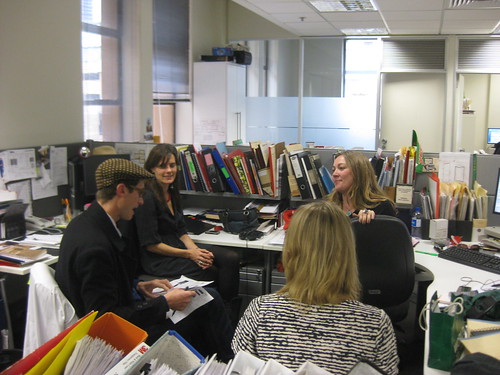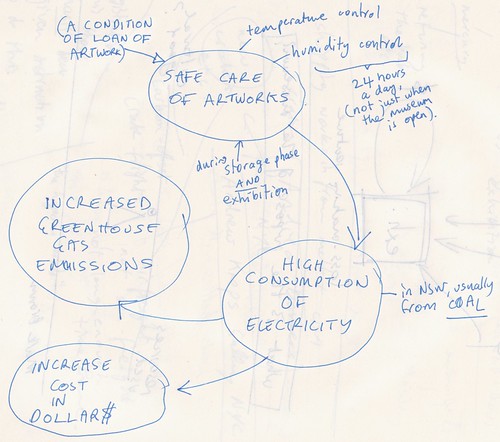
[Here I am with Megan, Claire and Melanie, as we brainstorm wildly about what their jobs involve, and the inherent difficulty of balancing safe care of artworks with care of the planet.
-Photo by Mark Booth…]
On Monday, I visited the MCA for my first “departmental consultation”. I met with Claire, Megan and Melanie who work with the museum’s registration and conservation department.
“Registration” is the department that deals with the coming and going, transport, storage and packaging of art: taking stock of things as they enter, inhabit, and leave the museum.
Given that this realm is intimately connected to “imports and exports” (on a micro scale), I figured it was a key node in my Environmental Audit.
One of the big things this staunch trio faces is the need to weigh up the imperative to “do their jobs properly” with the desire to work a bit more sustainably.
For example, when artworks are on show in the gallery, they are supposed to be kept at a relatively stable temperature (20 degrees) and humidity (55%). If these values fluctuate greatly, the materials which make up an artwork can begin to warp, melt, sweat, decay, molder or crack.
These rules are strictly monitored by swish electronic devices. Often, a loan from another institution is conditional on weekly data readouts from one of these machines, so that the owner can be sure the work is properly taken care of. But this aint easy, especially in an old, re-purposed building like the MCA, with a retrofitted airconditioning system. Especially in the hot summer, it can be a (very expensive) battle to make sure temperature and humidity are kept in the correct range. Electricity costs make a significant dent in the museum’s operating budget.
And now, in the era of environmental budgeting, there is a third factor thrown into the ring: carbon emissions.
In other words, the very act of exhibiting artworks can be really expensive, not to mention polluting. I’ve only given one example here. But after chatting with the registrars, I scrawled this diagram in an attempt to understand what goes in, and what comes out, when a work of art is shown at the museum:
To the left of the diagram, you have all the “inputs” required to get that artwork on show…
…and to the right, the various “outcomes” which result from the art having a brief soujourn in the museum.
Holy Crucial Blindspot Batman! (a disclaimer):
So… when I say I’ve included “all” the inputs and outcomes, I’m certain that’s not the whole truth.
For example, I humbly and shamefacedly admit that after scanning and uploading the diagram, I noticed that I’ve omitted something rather important from the left hand side of the equation: the production of the artwork by the artist. What a gaff!
Also missing from the left side are things like the social networks that have to be developed in order to make an exhibition happen. And I’m sure there’s plenty more blindspots where those came from…
However, for the moment let us consider these mistakes a gift, and emblematic of the task at hand: the fiendish difficulty in taking everything into account.
There will always be something outside the current frame of reference. Hopefully this audit will help to draw these hidden factors to the surface.
In the meantime, here’s a great, brand new essay from an industry handbook of Museum Registration Methods. The article is called “Registrars and Sustainability, An Introduction to the Issues and a Call for Action” by Lea Foster Warden and Sara Frantz. As a bonus, the version I’ve scanned and posted here (for educational purposes, naturally) is complete with my scrawled notes and underlinings.
…and I’ve posted up a bunch of links to “green museum” stuff in the right hand column of this blog – many of these links are drawn from that essay.



update from Claire, the registrar:
these are the swish electronic tags the MCA uses to monitor humidity and temperature:
“HDL, Australia’s portable data logging specialists”… Kinda like little robotic auditors themselves…
Pingback: A Model Museum? « Environmental Audit
Hi Lucas.
Now it’s not like you need any more information, I know. But the latest Registrar’s journal has an article on Sustainability in the Museum Context.
You might like the diagrams!
Here is an excerpt from it:
http://www.rmit.edu.au/browse;ID=64zmbqnfcc0u